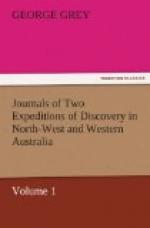November 9.
I caught four albatrosses with a fishing-line; one of them was a female, the first I had seen. I observed no marked difference between her and males of the same species, for I have found them vary much in the dark shades upon their feathers.
I have yet found no bird of this family whose foot was not longer than its beak.
Diomedea exulans—Female.
Length from tip of wing to tip of wing,10 feet 10
inches.
Length from tip of wing, 4 feet 10 inches.
From tip of beak to tip of tail, 4 feet 9 inches.
Length of beak, 7.2 inches.
Length of tail, 9 inches.
Length of foot, 7.5 inches.
The black and brown marks on this bird were darker than the corresponding ones on the males.
I am inclined to think that the chief characteristic that distinguishes the females from the males in the family Longipennes is their greater size: my opinion is grounded upon the following tables, drawn up from careful measurements, made by myself.
(@@@Table of family Longipennes)
In each of these three instances the female is larger than the males; they are the only ones I am able to adduce which bear upon this point.
November 11. South latitude 30 degrees 47 minutes; east longitude 100 degrees 21 minutes 15 seconds.
Being a calm, I gave the men leave to bathe this afternoon, and was one of the first overboard myself. Within an hour and a half after we had done bathing, a cry of a shark was raised, and in truth there was the monster (the first we had seen). I mention this fact as tending to support what I have often heard stated, namely, that a shark’s sense of smell is so keen that, if men ever bathe in seas where they are found, a shark is almost sure to appear directly afterwards. This really occurred in the present instance.
We repeatedly caught many little animals which I believe are the VELELLA of Lamarck. They consist of a flat oval cartilage, on which they float; there is a mouth in the inferior surface of this surrounded with many tentacula; on its superior surface is a crest which remains above water, and the wind blowing against it turns the animal round; they thus swim with a rotatory motion; the crest is placed obliquely to the length of the oval cartilage, and this position of it perhaps assists in producing the motion; the crest is perfectly transparent, but marked with little striae; the oval cartilage is marked with concentric striae, which indicate the lines of its growth; in some this cartilage is transparent, in others quite blue.
November 12. South latitude 30 degrees 11; east longitude 100 degrees 31 minutes 30 seconds.
We caught several beautiful animals this day, of the Medusae kind (Diphya). (See Illustration 3 Diphya, Sp.)
Figure 1 represents a section through one of them, the size of life: the bag (1) is of a delicate bright amber colour. The long tentacula issuing out are upwards of a foot in length and of a bright flesh colour.




